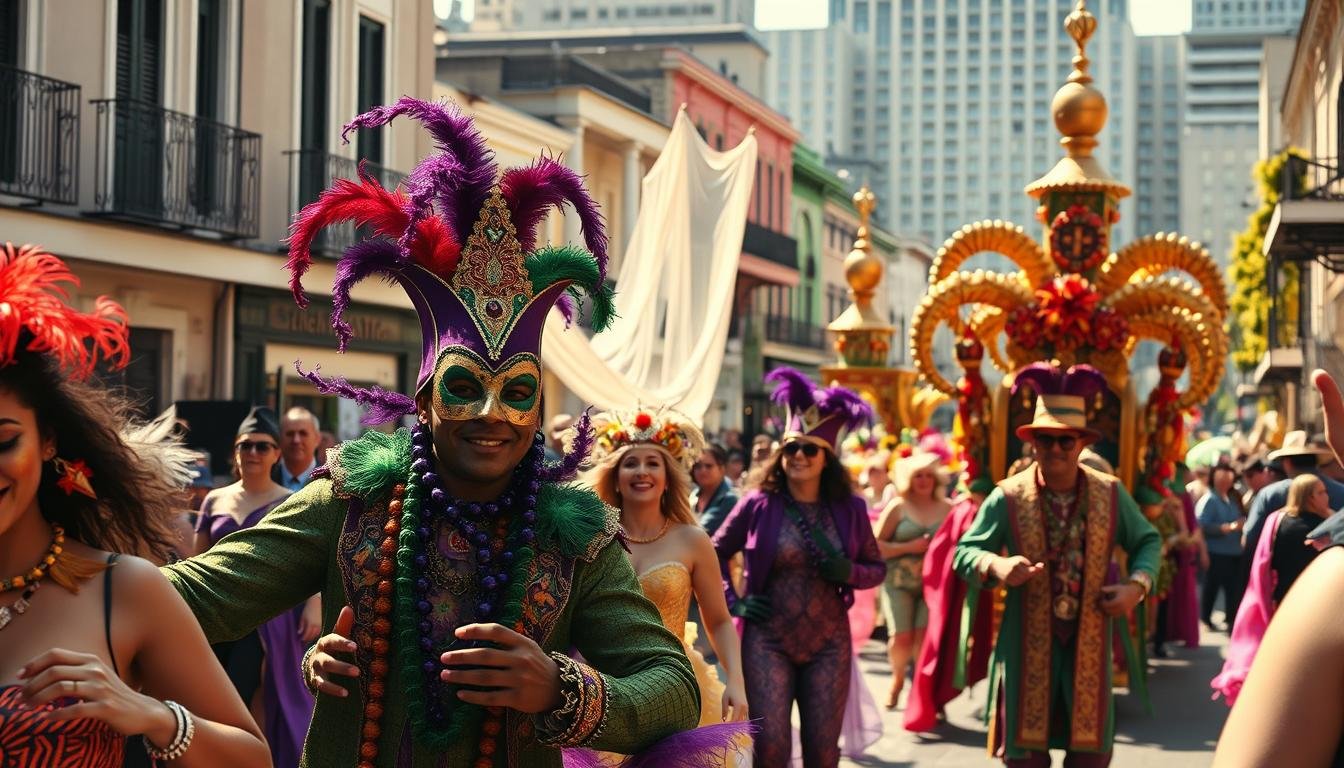As a local, I’m excited to share with you the rich history and vibrant traditions of Mardi Gras in New Orleans. This annual celebration is a must-see, with its colorful parades, lively music, and delicious Creole cuisine.
The origins of Mardi Gras date back to medieval Europe, but in New Orleans, it’s evolved into a unique spectacle that blends French, Spanish, and African influences. From the historic French Quarter to the energetic streets of the Marigny, Mardi Gras is a true reflection of the city’s cultural heritage.
Key Takeaways
- Discover the history and evolution of Mardi Gras in New Orleans
- Explore the key symbols and traditions that make Mardi Gras unique
- Learn about the major events and parades that take place during the festival
- Get insider tips on the best places to experience Mardi Gras in the city
- Understand the cultural significance of Mardi Gras in New Orleans
The Origins of Mardi Gras in New Orleans
New Orleans’ Mardi Gras is a vibrant celebration that has its roots in the city’s unique cultural melting pot. As a local, I’ve seen firsthand how this festive season brings the community together, blending tradition with modern revelry.
The Historical Significance
The first Mardi Gras parade was held in 1837 by a group of wealthy planters and businessmen known as the Mistick Krewe of Comus. This event marked the beginning of a long-standing tradition that has been shaped by the city’s history. The cultural significance of Mardi Gras in New Orleans cannot be overstated, as it reflects the city’s resilience and creativity in the face of adversity.
Over time, Mardi Gras evolved, influenced by the various cultures that call New Orleans home. The city’s strategic location made it a melting pot of French, Spanish, African, and other influences, all of which are evident in the modern celebration.
Cultural Influences
The African, French, and Spanish traditions have played a significant role in shaping Mardi Gras. From the complex rhythms of African drumming to the elegant masquerade balls of European heritage, each culture has contributed to the rich tapestry of the carnival season in New Orleans.
The blending of these cultures is evident in the music, dance, and art that characterize Mardi Gras. For instance, the jazz music that fills the streets during Mardi Gras is a quintessential New Orleans sound, born from the fusion of African and European musical traditions.
Evolution Over the Years
Mardi Gras has not remained static; it has evolved significantly over the years. From its early days as a small, elite celebration, it has grown into a massive, city-wide event that attracts millions of visitors. The modern Mardi Gras is a testament to the city’s ability to adapt and innovate while maintaining its cultural heritage.
Today, Mardi Gras in New Orleans is a celebration that is both deeply rooted in tradition and dynamically evolving. It continues to be a vital part of the city’s identity, reflecting its history, cultural diversity, and community spirit.
Key Symbols of Mardi Gras
As a local, I can tell you that Mardi Gras is more than just a party; it’s a time when symbols and traditions come alive. The celebration is rich in iconic symbols that reflect the city’s history and culture.
The Colors and Their Meanings
The colors of Mardi Gras – purple, green, and gold – are more than just a visual spectacle; they carry significant meaning. Purple represents justice, green represents faith, and gold represents power. These colors were chosen in 1872 by the Rex Krewe, one of the oldest Mardi Gras organizations, to symbolize the values of the celebration.
Iconic Masks and Costumes
Masks and costumes are an integral part of Mardi Gras, allowing participants to express themselves and embody the spirit of the celebration. Historically, masks were used to allow people to mingle across social classes, and today, they continue to add an air of mystery and excitement to the parades.
The creativity and craftsmanship that go into making these masks and costumes are truly remarkable. Many participants spend months designing and creating their attire, often with intricate details and themes that reflect the krewe’s parade theme or personal interests.
The Role of King Cakes
No Mardi Gras celebration is complete without the King Cake, a sweet bread that is traditionally eaten during the carnival season. The cake is usually decorated with purple, green, and gold icing and sugar, and it contains a hidden plastic baby, representing the baby Jesus.
Whoever gets the piece with the baby is said to have good luck for the year and is often tasked with hosting the next King Cake party or bringing the cake to the next gathering. This tradition adds a fun and interactive element to the Mardi Gras celebrations.
| Symbol | Meaning |
|---|---|
| Purple | Justice |
| Green | Faith |
| Gold | Power |
Major Mardi Gras Parades
The Mardi Gras parades in New Orleans are a kaleidoscope of color, music, and joy, showcasing the city’s festive spirit. These parades are the heart of the Mardi Gras celebration, featuring elaborate floats, marching bands, and of course, the iconic throws that have become a hallmark of the festivities.
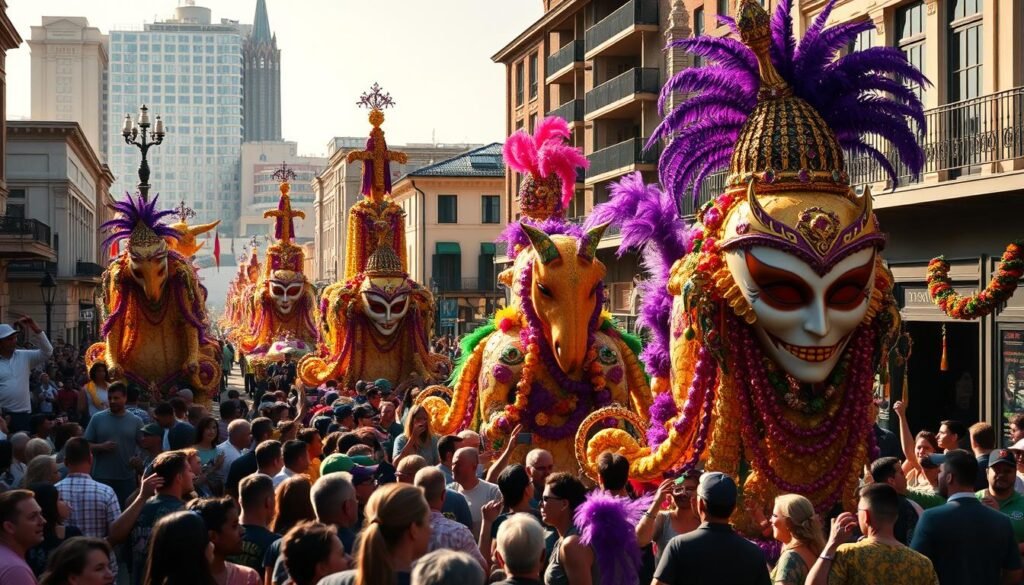
The Krewe of Bacchus
The Krewe of Bacchus is one of the most renowned krewes in New Orleans, known for its celebrity monarchs and extravagant floats. Their parade is a highlight of the Mardi Gras season, attracting large crowds with its unique blend of entertainment and tradition.
The Krewe of Bacchus has a long history of hosting spectacular parades, with a focus on mythology and culture. Their floats are designed to be visually stunning, often featuring intricate details and elaborate designs.
The Krewe of Endymion
The Krewe of Endymion is another prominent krewe that puts on a grand show during Mardi Gras. Their parade is one of the largest in the city, featuring massive floats and a variety of performances.
The Krewe of Endymion is known for its community involvement and charitable efforts, making their parade not just a celebration but also a way to give back to the community.
The Zulu Social Aid & Pleasure Club
The Zulu Social Aid & Pleasure Club is a historically significant krewe, being one of the oldest African American social aid organizations in New Orleans. Their parade is a cherished tradition, featuring hand-painted coconuts and other unique throws.
The Zulu Krewe is celebrated for its cultural significance and contributions to the Mardi Gras celebrations. Their parade is a testament to the rich cultural heritage of New Orleans, blending African American traditions with the broader Mardi Gras festivities.
These krewes, along with others, contribute to the vibrant tapestry of Mardi Gras parades in New Orleans, making the city’s celebration truly unique. Whether you’re watching from the French Quarter or participating in the festivities, the parades are an unforgettable experience.
Mardi Gras Music and Celebrations
The rhythm of Mardi Gras in New Orleans is unmistakable, and it’s all thanks to the city’s rich musical heritage. As we dive into the heart of the celebration, it’s clear that music plays a vital role in making Mardi Gras an unforgettable experience.
Traditional Jazz and Second Line
Traditional jazz is the backbone of Mardi Gras music in New Orleans. The sound of brass bands, with their trombones, trumpets, and tubas, is synonymous with the city’s Mardi Gras celebrations. Second-line parades, a unique aspect of New Orleans culture, feature these brass bands leading the way, accompanied by dancing and revelry.
The second-line tradition has its roots in African American culture, dating back to the late 19th century. It’s characterized by a “first line” of parade participants, often with elaborate costumes, followed by a “second line” of dancers and onlookers who join in the procession. This tradition is a testament to the city’s ability to blend cultural influences into something uniquely New Orleans.
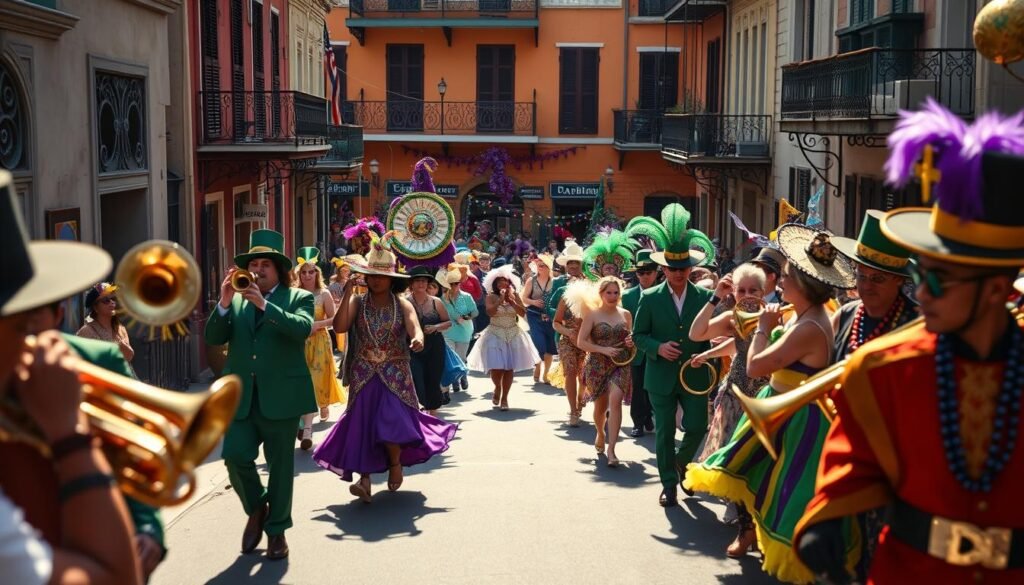
Popular Mardi Gras Songs
Certain songs are staples of Mardi Gras in New Orleans, evoking the spirit of the celebration. “When the Saints Go Marching In” is one such classic, sung and played by brass bands throughout the city during the carnival season. Other popular tunes include “Do You Know What It Means to Miss New Orleans” and “Mardi Gras Mambo.”
- “When the Saints Go Marching In” – a gospel song turned Mardi Gras anthem
- “Do You Know What It Means to Miss New Orleans” – a song that captures the longing for the city
- “Mardi Gras Mambo” – an upbeat tune that gets everyone dancing
Unique Musical Traditions
New Orleans is known for its ability to blend different musical styles, creating something entirely new and unique. The city’s Mardi Gras celebrations are no exception, featuring a mix of traditional jazz, gospel, and rhythm and blues. The result is a vibrant musical landscape that’s quintessentially New Orleans.
One of the most distinctive aspects of Mardi Gras music is the use of call-and-response patterns, where a leader sings or plays a phrase, and the crowd responds. This interactive element adds to the energy and spontaneity of the celebrations, making each Mardi Gras experience unique.
Signature Mardi Gras Foods
Mardi Gras in New Orleans isn’t just about the parades; it’s also a time to indulge in the city’s rich culinary heritage. The city’s cuisine is a melting pot of flavors, reflecting its cultural diversity.
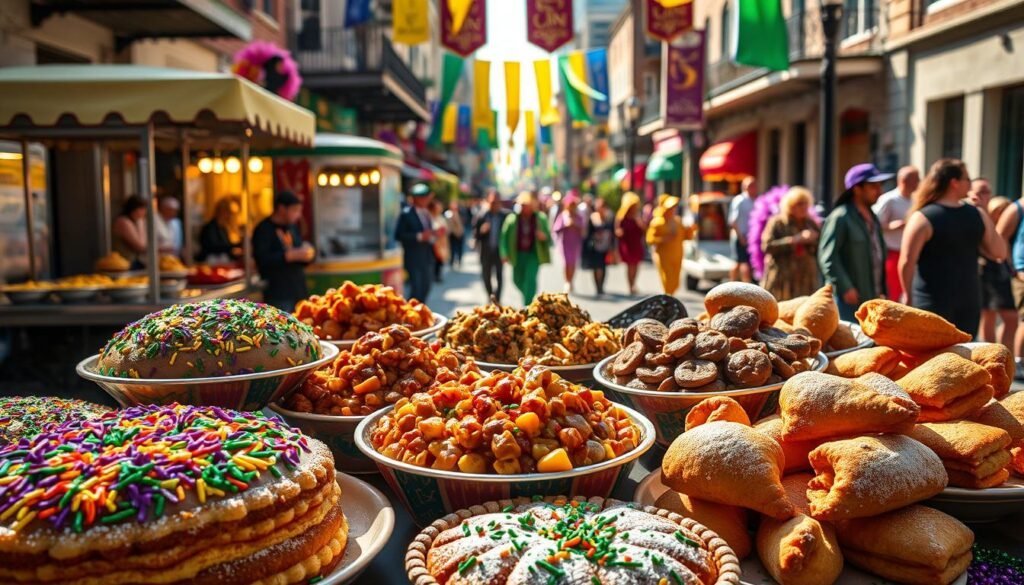
Beignets: A Sweet Tradition
Beignets, those sweet, deep-fried dough pastries covered in powdered sugar, are a Mardi Gras staple. You can’t walk through the French Quarter during Carnival season without catching the scent of beignets wafting from Cafe du Monde. This iconic cafe has been serving beignets since 1862, making them a part of New Orleans’ culinary tradition.
Enjoying beignets is more than just a sweet treat; it’s an experience. Sitting at a Cafe du Monde table, surrounded by the hustle and bustle of the French Quarter, and savoring a plate of beignets is a quintessential New Orleans experience.
The Famous King Cake
Another sweet tradition is the King Cake, a sweet bread that’s a staple during the carnival season in New Orleans. This circular bread is often filled with cream cheese or cinnamon and topped with icing and sugar. The king cake tradition is tied to the Epiphany, where a small plastic baby (representing the baby Jesus) is hidden inside the cake. Whoever gets the piece with the baby is said to have good luck for the year and is often tasked with hosting the next King Cake party.
Gumbo and Jambalaya Delights
No discussion of New Orleans cuisine would be complete without mentioning gumbo and jambalaya. These hearty dishes are staples at Mardi Gras parties and gatherings throughout the city. Gumbo, a rich stew made with a combination of ingredients like okra, rice, and a variety of meats and seafood, is a flavor sensation. Jambalaya, a one-pot dish made with sausage, chicken, and rice, is another crowd-pleaser.
Both dishes embody the spirit of New Orleans cuisine: rich, flavorful, and deeply rooted in the city’s cultural heritage. As you enjoy these dishes during Mardi Gras, you’re participating in a culinary tradition that’s been years in the making.
The Role of Krewes
The krewes are the backbone of Mardi Gras, bringing the celebration to life with their vibrant parades and events. These social organizations have been the driving force behind the festivities for generations, each with its own unique traditions and themes.
Defining a Krewe
A krewe is essentially a group of people who come together to organize and participate in Mardi Gras events. They are responsible for creating the floats, costumes, and performances that make Mardi Gras so spectacular. Krewes often have their own membership requirements, rituals, and histories, adding a layer of depth to the Mardi Gras experience.
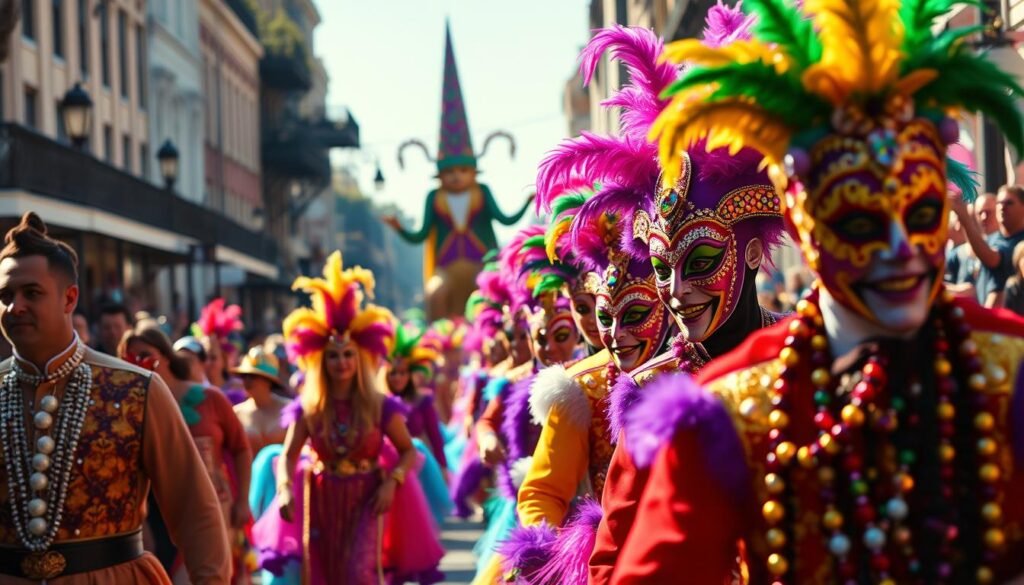
Notable Krewes and Their Themes
Some of the most well-known krewes include the Krewe of Bacchus, the Krewe of Endymion, and the Zulu Social Aid & Pleasure Club. Each of these krewes has its own distinct theme and style, contributing to the rich tapestry of Mardi Gras. For example, the Krewe of Bacchus is known for its celebrity monarchs and elaborate floats, while the Zulu Krewe is famous for its hand-painted coconuts and historic significance. You can explore more about these and other krewes on the Mardi Gras New Orleans website.
| Krewe Name | Notable For | Theme |
|---|---|---|
| Krewe of Bacchus | Celebrity Monarchs, Elaborate Floats | Varied Yearly Themes |
| Zulu Social Aid & Pleasure Club | Hand-painted Coconuts, Historic Significance | Cultural Heritage |
| Krewe of Endymion | Large Attendance, Extravagant Floats | Varied Yearly Themes |
How Krewes Contribute to the Festivities
Krewes contribute to Mardi Gras in countless ways, from designing and building floats to performing and throwing “throws” to the crowds. Their efforts make the event a truly immersive experience, blending music, art, and community spirit. The cultural significance of Mardi Gras is deeply intertwined with the work of these krewes, making them indispensable to the celebration.
In essence, krewes are the heartbeat of Mardi Gras, infusing the event with creativity, tradition, and joy. Their contributions ensure that Mardi Gras remains a unique and unforgettable experience for both locals and visitors.
Unique Mardi Gras Customs
As a local, I can attest that Mardi Gras is more than just a party – it’s a time-honored celebration steeped in history and culture. The streets of New Orleans come alive with a kaleidoscope of colors, sounds, and traditions that make Mardi Gras an unforgettable experience.
The French Quarter, in particular, is a hub of activity during Mardi Gras, with its historic architecture providing a stunning backdrop for the French Quarter celebrations. The air is filled with the sounds of jazz and the scent of delicious Creole cuisine, enticing visitors to join in the revelry.
Throws and Trinkets
One of the most exciting aspects of Mardi Gras is the tradition of “throws” – the beads, cups, and other trinkets tossed from floats to the crowds below. It’s a thrilling experience, with participants eagerly awaiting the next big catch. The Krewe of St. Anne, for example, is known for their creative throws, which range from handmade crafts to unique souvenirs.
The Legend of Rex
The legend of Rex, the King of Mardi Gras, is an integral part of the celebration’s history and identity. Rex is more than just a symbol – he represents the spirit of Mardi Gras and the city’s rich cultural heritage. The Rex organization, one of the oldest Mardi Gras krewes, continues to play a significant role in shaping the festivities.
During the masquerade balls in New Orleans, Rex is often the central figure, embodying the mystery and grandeur of the occasion. These balls are a highlight of the Mardi Gras season, offering a glimpse into the city’s storied past and its love of pageantry.
Family-Friendly Traditions
Mardi Gras is often associated with wild parties, but it’s also a celebration that welcomes families. The Krewe of Freret, for instance, hosts a parade that’s specifically designed to be fun for all ages. With its colorful floats and lively music, it’s a great introduction to Mardi Gras for kids.
Many krewes now incorporate family-friendly traditions into their parades, ensuring that Mardi Gras is an enjoyable experience for everyone. Whether it’s through special throws or kid-oriented themes, there’s a growing emphasis on making Mardi Gras accessible to families.
When to Experience Mardi Gras
Mardi Gras in New Orleans is an experience like no other, and timing is everything. The city’s carnival season is a prolonged celebration that builds up to the main event.
The carnival season in New Orleans typically begins on January 6th, also known as King’s Day, marking the start of the Mardi Gras season. This period is filled with various parades and events leading up to Fat Tuesday, the day before Ash Wednesday.
The Carnival Season Timeline
The season is packed with numerous events and parades, starting from January 6th. Some of the notable krewes begin their parades in late January and continue through February.
Understanding this timeline is essential for planning your trip. If you’re looking for a more relaxed experience, consider visiting during some of the earlier parades.
Major Event Dates
Some of the most anticipated events include the Rex parade, the Zulu parade, and the French Quarter parade. These events are usually scheduled on different days leading up to Fat Tuesday.
- The Rex parade is one of the oldest and most prestigious parades.
- The Zulu parade is known for its historic significance and the throwing of coconuts.
- The French Quarter parade is a more recent addition but has quickly become a favorite among locals and visitors alike.
Tips for Planning Your Visit
To make the most of your Mardi Gras experience, consider staying in the French Quarter or nearby neighborhoods. Be prepared for large crowds and multiple parades.
Planning ahead is crucial. Book your accommodations early, as hotels tend to fill up quickly during the Mardi Gras season. Additionally, familiarize yourself with the parade routes and schedules to ensure you catch the events you want to see.
By understanding the carnival season timeline and major event dates, you can plan a memorable trip to New Orleans during Mardi Gras.
Safety and Etiquette for Mardi Gras
As you join in the vibrant celebration of Mardi Gras in New Orleans, it’s essential to prioritize your safety and respect the local customs that make this event so unique. The cultural significance of Mardi Gras is deeply rooted in its history, and being a responsible visitor helps preserve this heritage.
Crowd Safety Tips
Stay aware of your surroundings, keep a close eye on your belongings, and follow instructions from law enforcement and krewe members. In the midst of the excitement, it’s easy to get caught up in the moment – but being mindful of your environment ensures a fun and safe experience for everyone.
Respecting Local Traditions
Mardi Gras is a time-honored tradition in New Orleans, with a rich Mardi Gras history that spans centuries. By respecting local customs and participating in the festivities with sensitivity, you contribute to the enduring spirit of the celebration.
Enjoying Responsibly
As you soak up the jazz, savor the Creole cuisine, and marvel at the elaborate parades, remember to pace yourself and enjoy the experience responsibly. By doing so, you’ll help maintain the joyous atmosphere that defines Mardi Gras in New Orleans.
FAQ
What is the history behind Mardi Gras in New Orleans?
Mardi Gras in New Orleans has a rich and complex history, shaped by the city’s cultural melting pot. The first Mardi Gras parade was held in 1837 by a group of wealthy planters and businessmen, known as the Mistick Krewe of Comus.
What are the traditional colors of Mardi Gras, and what do they represent?
The traditional colors of Mardi Gras are purple, green, and gold, representing justice, faith, and power, respectively.
What is the significance of King Cake during Mardi Gras?
King Cake is a sweet bread traditionally eaten during the carnival season, often containing a hidden plastic baby representing the baby Jesus. Whoever gets the piece with the baby is said to have good luck for the year.
What are some of the most notable Mardi Gras parades in New Orleans?
Some of the most notable Mardi Gras parades include the Krewe of Bacchus, the Krewe of Endymion, and the Zulu Social Aid & Pleasure Club, each offering unique floats, costumes, and traditions.
What is a Krewe, and how do they contribute to Mardi Gras?
A Krewe is a social organization that puts on Mardi Gras parades and events, creating elaborate floats, costumes, and performances that make Mardi Gras a truly unique experience.
What are some traditional Mardi Gras foods?
Traditional Mardi Gras foods include beignets, King Cake, gumbo, and jambalaya, showcasing the city’s rich Creole cuisine.
When does the Mardi Gras season typically take place?
The Mardi Gras season typically begins on January 6th (King’s Day) and ends on the day before Ash Wednesday.
How can I stay safe during Mardi Gras celebrations?
To stay safe, be aware of your surroundings, keep an eye on your belongings, and follow instructions from law enforcement and krewe members.
What is the cultural significance of Mardi Gras in New Orleans?
Mardi Gras is a vibrant reflection of New Orleans’ diverse heritage, celebrating the city’s history, music, and cultural traditions.
What are some unique customs associated with Mardi Gras?
Unique customs include the throws and trinkets handed out during parades, masquerade balls, and the legend of Rex, the king of Mardi Gras.
